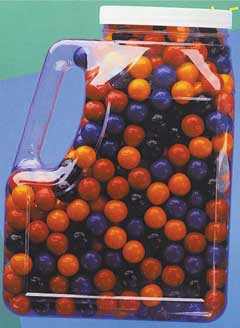
The solution is to subtly reduce club store container sizes while upholding the brand—ushering in more smaller big-mouth containers made with improved design techniques.

“Tweaking container size and shape is becoming faster and easier than ever before, and it can deliver significant payback,” explains Podnar. “Reducing diameter by a quarter-inch may be virtually imperceptible to consumers, but it can help a food manufacturer hit a critical price point by reducing total costs by eight to 10 per cent or more.
“Amid today’s cutthroat competition, this can really help to win bids and shelf-space.”
The new “small bulk” containers—typically ranging in size from about 48 ounces to a half-gallon—are helping the more traditional, smaller grocers to enter the bulk-foods market that has long been dominated by the club and warehouse-type stores.
“Non-club stores who may have wanted to do efficient pallet pack merchandising, but without the excessive bulk of club stores, are now offering ‘small bulk’ containers at their end caps,” says Podnar. “This minimizes stocking and handling, and it can be especially effective with the wide-mouth containers.”
Clear Choice
Since the “small bulk” wide-mouth containers are clear, strong and presentable, they eliminate wasteful packaging practices such as partitioning, outer wrappings, or using protective boxes within boxes, according to Podnar.
“Another big plus for the ‘small bulk’ wide-mouth containers is that consumers often actively seek them out, so that they can later reuse them at home to store cookies, cereals, toys, nails, crayons, craft items and many other objects,” says Podnar.
“Today’s marketers and brand managers are really starting to appreciate how the reuse of their containers can keep their brand in front of the consumer indefinitely.”
Whether food manufacturers are rushing to make last-minute changes or to meet customer deadlines, speed-to-market can often make the difference between winning the bid and shelf-space or not, points out Podnar.
“And in this rush to merchandise, the brand must never be compromised,” he asserts. “From stock to custom packaging, container shape, size, and even color can be as much a part of brand as the label.
Advertisement

